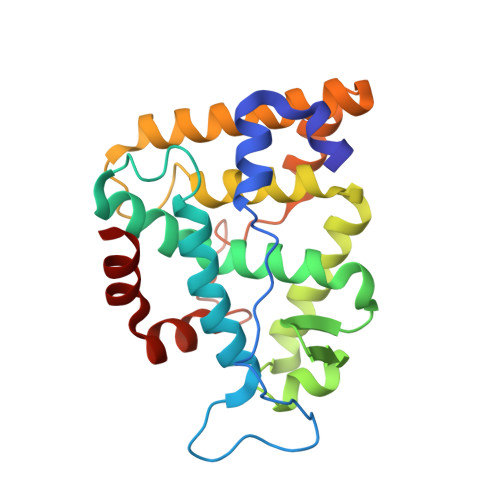A novel nuclear receptor subfamily enlightens the origin of heterodimerization.
Beinsteiner, B., Markov, G.V., Bourguet, M., McEwen, A.G., Erb, S., Patel, A.K.M., El Khaloufi El Khaddar, F.Z., Lecroisey, C., Holzer, G., Essabri, K., Hazemann, I., Hamiche, A., Cianferani, S., Moras, D., Laudet, V., Billas, I.M.L.(2022) BMC Biol 20: 217-217
- PubMed: 36199108
- DOI: https://doi.org/10.1186/s12915-022-01413-0
- Primary Citation of Related Structures:
7Q71 - PubMed Abstract:
Nuclear receptors are transcription factors of central importance in human biology and associated diseases. Much of the knowledge related to their major functions, such as ligand and DNA binding or dimerization, derives from functional studies undertaken in classical model animals. It has become evident, however, that a deeper understanding of these molecular functions requires uncovering how these characteristics originated and diversified during evolution, by looking at more species. In particular, the comprehension of how dimerization evolved from ancestral homodimers to a more sophisticated state of heterodimers has been missing, due to a too narrow phylogenetic sampling. Here, we experimentally and phylogenetically define the evolutionary trajectory of nuclear receptor dimerization by analyzing a novel NR7 subgroup, present in various metazoan groups, including cnidarians, annelids, mollusks, sea urchins, and amphioxus, but lost in vertebrates, arthropods, and nematodes. We focused on NR7 of the cephalochordate amphioxus B. lanceolatum. We present a complementary set of functional, structural, and evolutionary analyses that establish that NR7 lies at a pivotal point in the evolutionary trajectory from homodimerizing to heterodimerizing nuclear receptors. The crystal structure of the NR7 ligand-binding domain suggests that the isolated domain is not capable of dimerizing with the ubiquitous dimerization partner RXR. In contrast, the full-length NR7 dimerizes with RXR in a DNA-dependent manner and acts as a constitutively active receptor. The phylogenetic and sequence analyses position NR7 at a pivotal point, just between the basal class I nuclear receptors that form monomers or homodimers on DNA and the derived class II nuclear receptors that exhibit the classical DNA-independent RXR heterodimers. Our data suggest that NR7 represents the "missing link" in the transition between class I and class II nuclear receptors and that the DNA independency of heterodimer formation is a feature that was acquired during evolution. Our studies define a novel paradigm of nuclear receptor dimerization that evolved from DNA-dependent to DNA-independent requirements. This new concept emphasizes the importance of DNA in the dimerization of nuclear receptors, such as the glucocorticoid receptor and other members of this pharmacologically important oxosteroid receptor subfamily. Our studies further underline the importance of studying emerging model organisms for supporting cutting-edge research.
Organizational Affiliation:
IGBMC (Institute of Genetics and of Molecular and Cellular Biology), Illkirch, France.
















